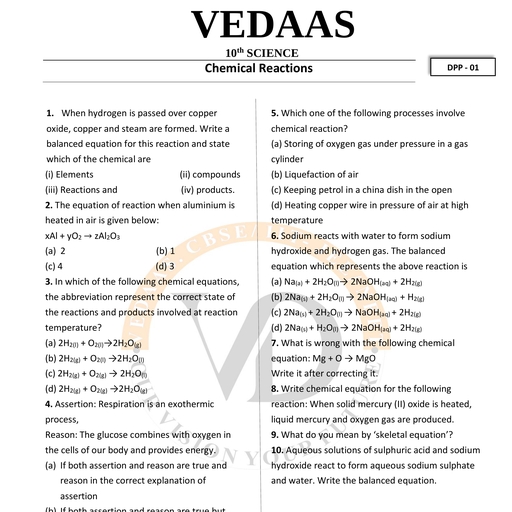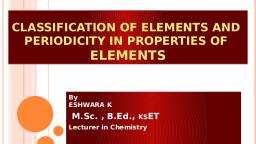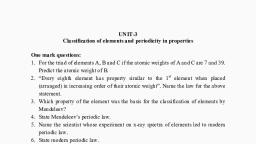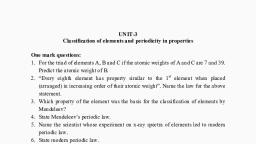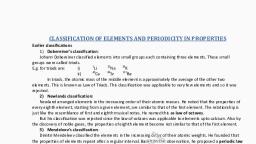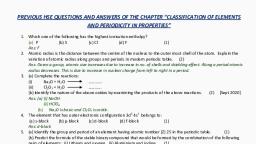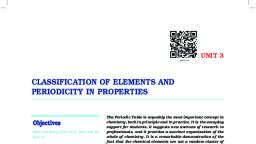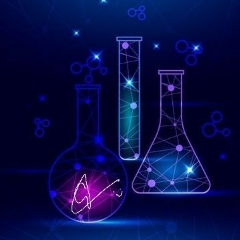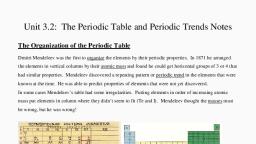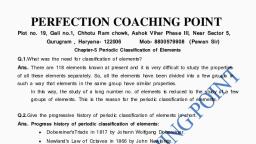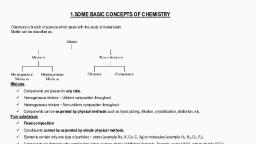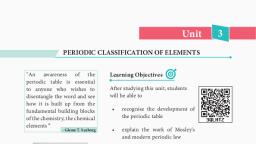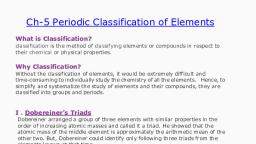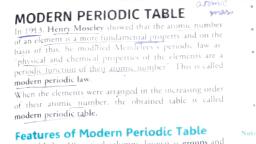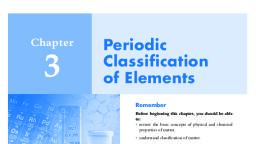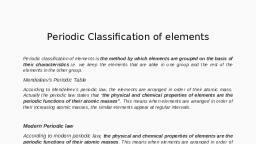Page 1 :
By:- Dheeraj Pandey, , Mob:- 9899372365, , Classification of elements and periodicity in properties, Class - XIth, Need for classification of elements, To remember a large quantity of elements, compounds and in order to remainder their, properties., Classification of elements: Arranging the elements in such a way that similar elements are, placed together while dissimilar elements are separated from each other., Periodic table: An arrangement of the known elements according to their properties in, tabular form., It also helps in predicting the new ones for undertaking further study., GENESIS (Historical development) OF THE PERIODIC CLASSIFICATION, Lavoisier classified the elements simply as metals & non – metals. However, this, classification proved to be inadequate., 1. Dobereiner’s Triads:- John Dobereiner grouped the elements as triads (a triads means a, group of three elements)., The atomic weight of the middle elements in each triad was found to be the average of the, atomic weight of first and third elements., Triad I, Lithium, Sodium, Potassium, , Triad II, At.Mass, 7, Calcium, 23, Strontium, 39, Barium, , Triad III, At.Mass, 40, 88, 137, , Chlorine, Bromine, Iodine, , At.Mass, 35.5, 80, 127, , Limitation: This classification of elements failed because it could not cover all the elements, known at that time., 2. Newland’s law of Octaves: It states that , “when the elements are arranged in increasing order of atomic weight, the, properties of energy eight element is similar to the first ones. This relationship is referred, to as” “law of octaves” to similarity with musical seal., Li, (7), Na, (23), , Be, (9), Mg, (24), , K, (39), , Ca, (40), , B, (11), Al, (27), , C, (12), Si, (29), , N, (14), P, (31), , O, (16), S, (32), , F, (19), Cl, (35.5), , Limitation:, (i) It failed while dealing with the heavier elements beyond Calcium (Ca)., (ii) When the noble gases were discovered, the idea of octaves could not be held. For e.g,, with the discovery of Neon between ‘F’ & ‘Na’, and ‘Ar’ between ‘Cl’ & ‘K’, it, becomes the ninth element and not the eighth, which has similar properties., , Chapter – 3, , Page 1
Page 2 :
By:- Dheeraj Pandey, , Mob:- 9899372365, , 3. Lother Meyer’s Arrangement: When the properties of the elements such as atomic volume, melting point and boiling, point are plotted as a function of their atomic weights, the elements with similar, properties occupied almost similar position., Lother Meyer proposed that ‘physical properties’ of the elements are a periodic function, of their weights., 4. Mendeleev’s Periodic Law:Mendeleev’s Periodic law states that “The physical and chemical properties of the, elements are a periodic function of their atomic masses”., Mendeleev’s Periodic Table:- “When elements are arranged in the increasing order of their, atomic weights, the elements with similar properties are repeated at regular intervals”. By, this scheme of arrangement, a table was constructed which was referred to as Mendeleev’s, Periodic table., (i) Systematic Study of elements:- Due to similarity in the elements of a group, it became, easier to remember the properties of a larger no. of elements., (ii) Correction of some atomic masses:E.g, Beryllium (At. mass was corrected from 13.5 to 9), (iii) Prediction of new elements, (iv) He introduced the concept of periods and groups, 8 Groups – AB Subgroups, 6 Periods, Anomalies And Defects in Mendeleev’s Periodic Table, (i) Position of Hydrogen:- Hydrogen has properties resembling with Group I (alkali metals), as well as Group VII – A (halogens) but the element was placed in group I., (ii) Anomalous Pairs:- Mendeleev placed some elements according to similarities in their, properties & not in increasing atomic masses., For e.g,:- Ar (39.9) was placed before K (39.1), Co (58.9) was placed before Ni (58.6), Te (127.6) was placed before I (126.9), These positions were not justified., (iii) Position of Isotopes:- For e.g, Isotopes of hydrogen with at. Masses 1, 2, 3 should be, placed at different places. But, Isotopes have not given separate places in the table., (iv) Some similar elements are separated and dissimilar elements are group together., For e.g, ‘Cu’ and ‘Hg’., (v) Unable to explain the cause of periodicity (tendency to reoccurs)., (vi) Position of lanthanoides & actinoids could not be explained satisfactorily., (vii) Classification was completely based on At. Weight., (viii) He doesn’t explain the proper position for inert gases., 5. Modern Periodic Law, Modern Periodic law states that “the physical and chemical properties of elements are the, periodic function of their ‘atomic number’.”, , Chapter – 3, , Page 2
Page 3 :
By:- Dheeraj Pandey, , , , , Mob:- 9899372365, , Electronic configuration as cause of periodicity:- The repetition of similar properties of, elements after certain intervals when the elements are arranged in order of increasing, atomic number is known as periodicity., The periodic repetition of properties is due to the repetition of elements after certain, intervals., “Long form of Periodic Table” consists of 18 vertical columns called groups and 7, horizontal rows called period., , THE GROUP IN THE PERIODIC TABLE, 1. Group I :- Alkali Metals, Highly reactive metals., Form strong bases which are soluble in H2O e.g, Na OH., 2. Group II :- Alkaline Earth Metals, Highly reactive metals., Found in earth’s crust., 3. Group III to XII :- Transition elements., 4. Inner transition elements : Lanthanoids & actinoids, 5. Group XIII :- Boron family, Boron is the first elements of group., 6. Group XIV :- Carbon Family, 7. Group XV :- Nitrogen family, 8. Group XVI :- Chalcogens, 9. Group XVII :- Halogens (because they form salts), 10. Group XVIII :- Noble gases or Inert gases, Chapter – 3, , Page 3
Page 5 :
By:- Dheeraj Pandey, , , , Mob:- 9899372365, , Group 1 : ns1 : alkali metals, Group 2 : ns2 : alkaline earth metals, General Characteristics, (i) Soft metals, (ii) Low ionization energies, (iii) Highly Electropositive, (iv) Very reactive and form ionic compounds, (v) Good reducing agents, (vi) Oxidation states : +1 and +2., , 2. p – block elements (Group 13 – 18), , , The elements in which the last electron enters the p – orbital of their outermost energy, level are called p – block elements., General configuration : ns2 np1-6, Group 13 : ns2np1 : Boron family, Group 14 : ns2np2 : Carbon family, Group 15 : ns2np3 : Nitrogen family, Group 16 : ns2np4 : Chalcogens, Group 17 : ns2np5 : Halogens, Group 18 : ns2np6 : Noble gases (He – 1s2), General Characteristics:, (i) Most of them are non – metals., (ii) Most of them are highly electro negative., (iii) They form ionic as well as covalent compounds., (iv) Most of them form acidic oxides., (v) They form variable oxidation states., Classification of p – block elements., If period = P and no, of valence e- = N, (P + 1) > N, then element is a metal., (P + 1) < N, then element is a non – metal., (P + 1) = N, then element is Metalloid., For e.g, For silicon (z = 14) p = 3, N = 4, P + 1 = 4 = N .’. Si : Metalloid., 3. d – block elements, The elements in which the last electrons enter the d – orbital of their last but one (called, penultimate) energy level constitute d – block elements., , , General configuration : (n – 1)d1-10 ns1-2, * Also known as transition elements., * Consist of 4 periods (4, 5, 6, 7th period), , General Characteristic:, (i) They are hard, high melting metals., (ii) They form coloured complexes., (iii) They show variable oxidation states., (iv) They form ionic as well as covalent compounds., (v) Most of them possess catalytic properties., Chapter – 3, , Page 5
Page 6 :
By:- Dheeraj Pandey, , Mob:- 9899372365, , 4. f – block elements, The elements in which the last electron enters the f – orbital of their atoms are called f –, called f – block elements., , , General Configuration : (n – 2)f1to14 (n – 1)d1or0 ns2, F – block elements : Inner transition elements, (Rare earth metals) lanthanoids – 4f1–14 5d0–1 6s2, (Radioactive nature) actinoids – 5f –14 6d0–1 7s2, , , , General Characteristics:, (i) They are high melting metals., (ii) They form coloured complexes., (iii) They slow variable oxidation states, (iv) They have high densities., (v) Most of them (actinoids) are radioactive in nature., The elements of Group 3 to 13 i.e, d – block are called transition elements because, they represent transition (change) in character from reactive metals on one side to non –, metals on other side. The elements of Group 3 to 13 containing f – block are called inner, transition elements., METHOD TO PREDICT THE ‘PERIOD’, GROUP AND BLOCK OF A GIVEN, ELEMENT, (i) Electronic configuration of the element is written with various rules. It should not be, changed under any circumstances., (ii) Period : Principal quantum no. of valence shell., (iii) Block : Subshell which receives the last electron., (iv) Group : Predicted on the basis of the no. of e– in the outermost or penultimate shell, as follows:a) If elements belong to s – block, group = (no. of valence e–)., b) If elements belong to p – block, group = 10 + (total no. of valence e–), c) If elements belong to d – block, group = 2 + (no. of (n – 1)d electrons), Advantage of Long form of periodic Table, (i) Classification was based on atomic number, thus no problem in position of isotopes., (ii) Periodic table is governed by electronic configuration which determines their properties., (iii) Easy to remember and reproduce., (iv) Systematic grouping of 4 blocks (s, p, d & f – blocks)., (v) Position of lanthanoids & actinoids was explained., Defects of Long form of periodic Table, (i) Position of hydrogen : Due to resemblance of properties with both Group I & VII., (ii) Lanthaniods & actiniods have not been accommodated in the main body of periodic table., (iii) Helium has electronic configuration of 1s2 which should be placed in s – block where as, it is placed above p – block., , PERIODIC PROPERTIES, 1. Atomic Radii is the distance from centre of the nucleus to the outermost shell of e-., , Chapter – 3, , Page 6
Page 7 :
By:- Dheeraj Pandey, , Mob:- 9899372365, , r : Atomic Radius, r, , Covalent Radius :- One half of the distance b/w the centres of the nuclei of two similar, c, atoms bonded by a single covalent bond., c : covalent radius, i : intermolecular, distance, , i, , Intermolecular Distance:- Distance b/w the centres of the two similar atoms bonded by a, single covalent bond., VARIATION OF ATOMIC RADII IN PERIODIC TABLE, (i) Period :- L to R At. radii decreases as At no., Reason : In morning from left to right across the period, the nuclear charge increases, progressively by one unit but the additional electron goes to the same principal shell. As, a result, the electron cloud is pulled closer to the nucleus by increased effective nuclear, charge. This results in a decrease in atomic size., Vander Waals Radius:- It is defined as half the inter-nuclear distance b/w two adjacent, atoms belonging to two nearest neighbouring molecules of the substance in the solid state., , Vander waal radius, , Some exceptions in the variation of at radii in a period:a) An increase in At. size is observed for noble gases. This is due to the fact that the values, of other elements are covalent radii, whereas for noble gases, it is Vander Waals Radius, as they don’t form covalent bond., b) Transitions elements exhibit little variation in At. radii. This is due to poor shielding, effect of d – electrons, c) Variation is also shown by lanthaniods due to lanthaniods contraction., (ii) Group:- Top to Bottom At. Radii., Reason : Number of shells increases on going down the group, therefore, nuclear charge, decreases resulting in increase in the radius of the element., 2 Ionic Radii :- It is the effective distance from the nucleus of the ion upto which it has an, influence in the ionic bond., Radius of +ve ion (cation) is always smaller than that of parent atom., Chapter – 3, , Page 7
Page 8 :
By:- Dheeraj Pandey, , , Mob:- 9899372365, , A cation is formed by the loss of one or more electrons from the gaseous atom. Therefore,, in case of cation, the effective nuclear charge per electron increases and the electrons are, more strongly attracted & are pulled towards the nucleus. This causes a decrease in the, size of ions., Eg:, Li, Li+ + e–, 2 1, (1s 2s ), (1s2), (152pm), (60pm), Ionic radii, , Radius of – ve ion (anion) is larger than that of parent atom., An anion is formed by the gain of one or more electrons in the neutral atom and the, number of electrons increases. As a result, effective nuclear charge is reduced and the, electron cloud is held less tightly by the nucleus. This causes increase of size of the ions., e.g :, Cl, Cl–, (At.no 17), (At.no 17+1 = 18), PERIODIC TREND IN IONIC RADII, Like covalent radii, the ionic radius also increases as we move down the group due to, increase in no. of shells., 3. Ionization Enthalpy (I.E.), Ionization Enthalpy is defined as the enthalpy change accompanying the removal of one, valence electron from an isolated neutral gaseous atom resulting in the formation of a, monovalent positive ion., Atom + IE, +ve ion + Electron, Eg., Li(g) + IE, Li+(g) + e–, Factors on which Ionisation Enthalpy Depends, i) Nuclear Charge α I.E, As nuclear charge , force of attraction between the nucleus and valence electrons also, increases. Thus, more energy is reqd. to remove valence electron., ii) Atomic Size α 1/I.E, As At. size , nuclear charge simultaneously, the size of the atom dominates effect of the, increase in the nuclear charge. As a result I.E decreases down the group., iii) Screening Effect, The reduction in force of attraction by the shell present in b/w the nucleus and valence, electrons is called screening or shielding effect., Screening effect of different orbitals : s > p > d > f, High screening effect less I.E required, iv) Penetration of Subshells, s – orbitals penetrate more closer to the nucleus and thus electrons require more energy to, be removed from the orbital., Thus, more than penetration power, more I.E required order:- s > p > d > f., v) Stable electronic configuration, Since half & Completely filled orbitals are more stable and thus require more I.E., VARIATION OF I.E IN PERIODIC TABLE, (i) Periods :- L to R due to in nuclear charge and in At. size, the valence e– are held more, tightly by the nucleus & thus the amount of energy reqd. to remove an e– keeps, Chapter – 3, , Page 8
Page 9 :
By:- Dheeraj Pandey, , Mob:- 9899372365, , on increasing., (ii) Groups :- I.E Decreases down the group as no. of shell and nuclear charge compensate, with increase in size., 4. Electron Gain Enthalpy or Electron Affinity (EA), Amount of energy released when an electron is added to an isolated gaseous atom is called, electron affinity., Atom(g) + electron, Anion(g) + Energy, –, Cl(g) + e, Cl- + Energy, Factors on which Electron Affinity Depends, i) Size of the atom, Smaller the size of the atom, strong is the attraction of its nucleus towards the electron to, be added. Thus, smaller the size of atom, greater is the electron gain enthalpy., ii) Magnitude of Nuclear Charge, the nuclear charge, stronger is the attraction of the nucleus towards the electron to be, added., iii) Electronic Configuration, Elements having stable half-filled or completely filled valence subshells show small, attraction & thus less electron Affinity., VARIATION OF ELECTRON AFFINITY IN PERIODIC TABLE, i) Period:- EA increases from L to R., Reason:- On moving from L to R, there is an increase in effective nuclear charge and, decrease in size, thus EA., ii) Group:- EA decreases from top to bottom., Reason:- From top to bottom, size of atom and there is a less attraction b/w nuclear and, valence e– and thus less EA., , , Exceptions In The General Trends, , i) Electron gains enthalpy of fluorine is unexpectedly less negative than that of chlorine., Why?, The low electron gain enthalpy of fluorine is due to very small size of fluorine atom. A a, Consequence of small size, there occurs strong inter – electronic repulsions in the, relatively compact 2p subshell of fluorine and the incoming electron does not feel much, attraction., ii) Electron Gain enthalpies of Be, Mg and N are nearly Zero., Due to extra stability of fully filled orbitals in Be(2s2) and Mg(3s2), there elements show, little tendency to gain electrons. Hence, Mg and Be have nearly zero electron gain, enthalpy. N(1s2 2s2 2p3) and P(1s2 2s2 2p6 3s2 3p3) have exactly half-filled 2p and 3p, orbitals, which are stable and thus N and P have lesser tendency to gain electrons., iii) Noble gases have positive value of electron gain enthalpy, Due to their highly stable configuration (i.e, feely filled valence shells), they have no, tendency to accept an additional e–. And show +ve value of EA., , Chapter – 3, , Page 9
Page 10 :
By:- Dheeraj Pandey, , Mob:- 9899372365, , iv) Halogens have highest EA, Halogens : ns2np5, Thus have only one electron less than the stable noble gas configuration. So as to acquire, noble gas. Configuration, halogens have max. tendency to accept an additional electron &, thus their electron gain enthalpies are very high., 5. Electronegativity, It is the tendency of the atom of an element to attract the shared pair of electrons towards, itself in molecule having bonded atoms., VARITION OF ELECTRONEGATIVITY IN PERIODIC TABLE, i) Periods:- Electronegativity from L to R as nuclear charge and size of atom., ii) Group:- Electronegativity from top to bottom, Reason:- From top to bottom, no, of shells and effective nuclear charge thus,, ELECTRON GAIN ENTHALPY, ELECTRONEGATIVITY, i) It is tendency of an isolated gaseous, i) It is the tendency of an atom in a, atom to attract an e–., molecule to attract shared pair of e–., ii) It is the property of an isolated atom., ii) It is the property of bonded atom., iii) It does not change regularly in a, iii) It changes regularly in a period or a, period or a group., group., iv) It is measured in electron volts/atom or iv) It is number and has no units., kcal/mol or kJ/mol., 6. Valency, The outermost shell of an atom is called valence shell and the number of electrons present, in the valence shell determine the valency of the atom., VARITIONS OF VALENCY IN PERIODIC TABLE, i) Periods: The no. of valance electrons increases from 1 to 8 on moving across a period,, however, the valency increases from 1 to 4 and then decrease to zero., ii) Groups:- All elements in a group have same valency., , , DIAGONAL RELATION SHIP, Some elements of certain groups in second period resemble certain elements of the next, higher group in the third period. This is called diagonal relationship., e.g, Li resembles Mg, Be resembles Al and B resemble Si., Causes:- i) Similarity in electron-positive character., ii) Similarity in atomic & ionic radii., iii) Similarity in polarizing power., , , , HEAD ELEMENTS:- Elements belonging to second period are sometimes called head, elements of their respective groups., , 7. Hydrogen Bonding, Hydrogen Bond:- The electron-static force of attraction b/w H – atom of one molecule and, a highly electronegative elements (such as N, O or F) present within the same molecule or, another of the same or different compounds is known as H – Bond., Cause for the formation of H – Bond, When H – atom is bonded to strongly electronegative element ‘X’, the electron pair, shared b/w the two atoms moves far away from H – atom. As a result, the H – atom, Chapter – 3, , Page 10
Page 11 :
By:- Dheeraj Pandey, , , , Mob:- 9899372365, , because highly electron-positive with respect to another atom ‘X’. Since there is, displacement of electron towards X, H atom acquires fractional positive charge (S+) while, ‘X’ attain fractional negative charge (S–). This results in the formation of a polar, molecule having electrostatic force of attraction;, HS+, XS– ------------- HS+, XS– ------------ HS+, XS –, The magnitude of H – bonding depends on the physical state of compound., It is max. in solid state & min in gaseous state., , Types of H – Bonds, i) Intermolecular H – bonds : Bond formed b/w two molecules of the same or different, compounds. E.g, HF, H2O, NH3, ii) Intermolecular H – bonds : Bond formed b/w hydrogen atom and N, O or F atom of the, same molecule. Intermolecular H – bonding ( or chelation) decreases the boiling point of, the compound and also its solubility in water by restricting the possibility of intermolecular, H – bonding, Bond Strength of Different Bonds., Covalent bond > Ionic bond > Hydrogen bond > dipole – dipole interaction, Vander, Waals Forces, , Chapter – 3, , Page 11











